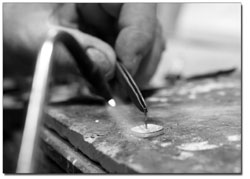|
| ||||
| Addicted to stone
by Stew Mosberg
Smith said the most time-consuming aspect of his restoration work is locating and matching gems and metals. Furthermore, stones are also the focal point of much of his custom-made pieces. As such, he admits to an addiction to stones. “My pieces are built around them,” said Smith, who is always looking for materials to work with or cache for future use. In his search, he frequently attends estate sales, surfs web sites such as eBay, and plies the aisles at gem shows. With Native American heritage in his blood, it is little wonder he gravitated toward tribal ornamentation, and his affinity for silver, turquoise and fossil-like stone is apparent in much of his craft. And while he has been called upon by the Center for Southwest Studies at Fort Lewis College to refurbish pieces in its collection, Smith said he is just as comfortable creating contemporary works as he is restoring antique ones. Originally from Tucson, and a resident of Durango for the past six years, Smith has garnered awards from the many shows he has participated in since 1999, including the well-respected Rancho Mirage show in California. However, shuttling between art shows, as many as 20 per year, finally caught up with Smith, and for the present at least, he has given up being an itinerant jewelry artist. “I went through three vehicles crisscrossing the West,” he says. Previously represented by Sorrel Sky Gallery, Smith now exhibits at Rain Dance Gallery in Durango and at a gallery in Albuquerque. Considering himself a designer rather than a jewelry repair professional, he also dabbles in photography and the majority of his photos, some of which are on view at his studio-shop, depict the Southwestern landscape he grew up in.
The pocket-sized shop is more of a studio than a retail establishment. Pondering the higher rents for Main Avenue, he opted instead for tiny quarters among a warren of offices on the second floor of the Gardenswartz Building. Not being visible from the street, he relies on word of mouth for clients. Peering into his showcase, one is struck by several unusually colored and patterned natural stones, “Picture Jasper,” he says by way of explanation. The muted samples look as if they are miniature painted landscapes, but in fact, are naturally patterned stones polished to a soft sheen, and in some cases, embedded in silver to be worn as two-sided jewelry. He calls these “secret scenery” pendants, just part of his portfolio, which is rife with jewelry ranging from traditional gold and silver necklaces to more “bizarre,” as he calls it, forms of wearable art. With his love of natural things and the beauty of the surrounding landscape, it is no wonder that Smith is environmentally conscious. “Eighty to 90 percent of materials I use are recycled,” he says proudly. Asked about the cost effectiveness of such a practice, Smith admits it saves him 10 to 20 percent. He also picks up old, sometimes discarded, tools and other lapidary equipment, and utilizing his lifelong talent for refurbishing, rebuilds them to meet his needs in the workshop. “Better than tossing them into the landfill,” he comments. As multi-faceted as a hand-cut gemstone, Smith has a peripheral interest in creating an artist’s directory and has been trying to do so for the past four years. Originally called Durangoarts.com, the directory met with limited local interest. He recently broadened his reach, “To reflect the bigger (art) community,” he said, and it now includes the Four Corners region. This latest attempt, www.4Cornersartsource.com , provides information about artists, galleries, organizations and suppliers, and has almost 90 listings. “It’s not a profit venture,” he acknowledges, “but it does take money, and I am hoping for support through donation.” He hopes to see it grow into a truly viable website, knowing full well that others are attempting to be the “go to” resource for the regional art population. His website suggests its purpose is to, “Promote regional artists, and the associated galleries and services by providing a regional directory for local artists and galleries, art shows, and related events, artist/gallery co-ops, services and suppliers.” While the jury is still out, Smith has accomplished a great deal to date, and his site just may prove to be another gem, one might say. •
|



 Bearded and be-spectacled, D. Robert Smith sits in his diminutive studio workspace behind a glass showcase of tiny gemstones and his custom designed jewelry. Bearing a last name that reflects his profession, Smith has been a self-described gemstone addict since he was 8 years old. Both his mother and grandfather were artists, and his father, a metal smith, was a personal friend of James Moody, the founder of the Tucson, Ariz., Gem and Mineral Society. That background provided Smith with a love for making things and a fascination with minerals that eventually led him to creating jewelry and repairing artifacts, tools and equipment. That affinity also helped form his passion for restoring Native American jewelry, some of which dates back to the 1880s.
Bearded and be-spectacled, D. Robert Smith sits in his diminutive studio workspace behind a glass showcase of tiny gemstones and his custom designed jewelry. Bearing a last name that reflects his profession, Smith has been a self-described gemstone addict since he was 8 years old. Both his mother and grandfather were artists, and his father, a metal smith, was a personal friend of James Moody, the founder of the Tucson, Ariz., Gem and Mineral Society. That background provided Smith with a love for making things and a fascination with minerals that eventually led him to creating jewelry and repairing artifacts, tools and equipment. That affinity also helped form his passion for restoring Native American jewelry, some of which dates back to the 1880s.